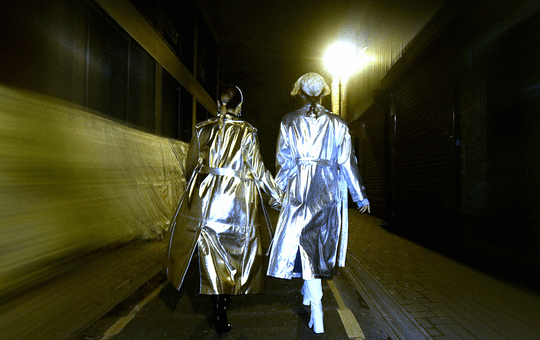X-TG - 'Desertshore'
The covers album – it’s hardly the most respected or well-mined form of musical expression ever. Even in more progressive areas of musical expression, covers projects that don’t have their tongues lodged in their cheeks, and are genuinely worthwhile, are usually few and far between. This is only more overt with covers of entire albums: as Simon Reynolds notes in his book Retromania, Beatles reworks by artists like Laibach in the eighties were, amongst other things, the next logical step in an ongoing “tribute-through-desecration” process that had began as the covers album gained momentum in the 70s.
Throbbing Gristle, trailblazers of what is now industrial noise music, never recorded a covers album in their original incarnation. However, they did allude to the medium with 1979’s ’20 Jazz Funk Greats’ LP. With its straight-faced cover art of a squeaky clean TG on a flowery clifftop, along with its wonderfully misleading title, it could be one of the most successful practical jokes ever played in modern music. Interestingly, it’s easy to imagine that TG might have recorded a “tribute-through-desecration” style piece, featuring caterwauling, piercing deconstructions of any number of canonical sixties works – stripping them of their decency and isolating some deviant sexual undertone that had rippled by unobserved in the album’s original form. But that’s partly what makes this “re-imagining” of Nico’s third album – a project dreamed up by TG member Peter “Sleazy” Christopherson and completed by two of his remaining bandmates, following his sudden passing in 2010 – all the more extraordinary. ‘Desertshore’, completed in part to honour Christopherson’s life and work, is devoid of any irony or playfulness, and reveals a serious, multilayered appreciation of its source material.
X-TG – ‘Desertshore / The Final Report’ previews and remixes
X-TG’s approach in reappraisal – X-TG being the name adopted by Throbbing Gristle’s remaining members after Genesis P-Orridge exited in 2010, six years after they reformed – is transformative; hardly the shock of the century for anyone with even a fleeting knowledge of what TG were/are all about. Out go the drone-like harmoniums and vast church-like reverberations of Nico’s ‘Desertshore’, and in come thrusting basslines and doom-ridden rhythms; pulsations are left to fester and unrecognisably contort before being reluctantly summoned back. But there are greater dualities and complexities operating here. To appreciate all the intricacies of this re-imagining is really a question of fully considering context – and of daring to stare the ensuing darkness dead in the eyes.
It’s all there in that ’20 Jazz Funk Greats’ cover. As has often been noted, it’s not merely the throwaway work of petty pranksters: TG stand – smiling widely – on the cliff edge of Beachy Head in East Sussex, one the world’s most notorious suicide spots. It’s an appropriate visual metaphor for a band that frequently teetered on the edges of the extremities of human experience: of death camps, of deception and coercion, of hardcore pornography. Although rooted in deeply personal emotions, Nico’s ‘Desertshore’ is also layered with extremes. Nico reflects throughout, with startling frankness, the piercing pains of being a mother unable to bring up her son, Ari. Le Petit Chevalier, featuring Ari, seems to voice these maternal yearns as he sings sweetly “I will come to visit you”. The contextual tragedy of ‘Desertshore’, a lamentation to Nico’s young child’s physical and emotional distance, are palpable; she would later lose her life in an accident while holidaying with Ari.
Nico – Le Petit Chevalier
In the hands of TG, the darkness and sense of suffering in the album is universalised: the eerie innocence of Le Petit Chevalier is melted away and manifests as an altogether more warped beast, featuring synthetic murmurs from brutal French director Gaspar Noé. Enthusiasts for Nico’s seminal album may argue that much of its dark power came through John Cale’s stark neoclassical production, and wonder how industrialists like X-TG could do anything but rob it of its shadowy, mediaeval beauty. But none of the chaos unfolded here is done merely for the sake of unpleasantness. As was further affirmed on this year’s mesmerising live recording of Carter Tutti Void, the members of TG have developed an alarmingly organic and directional approach to their noise experiments. They summon a maelstrom of sound with all the mastery and impulse of members of an orchestra, all becoming peculiarly elegant in their hands. The decision to invite an array of guest vocalists including Antony Hegarty, Marc Almond and ex-adult actress turned industrial artist Sasha Grey to help complete the ‘Desertshore’ project is revelatory, offering the chance to hear TG’s gnarly pulsations soar in a manner that could never previously have been imagined.
Along with the mostly instrumental ‘The Final Report’ LP, this looks set to be the final curtain call on the TG experiment. Through that most unlikely of things, a covers album, ‘Desertshore’ provides a fascinating collision of musical minds. It is one that calls on TG’s years of mucky majesty, while Nico’s emotional intensity breathes beautiful and confusing new life into their tumultuous universe.
Industrial Records released ‘Desertshore / The Final Report’ on the 26th November 2012.














